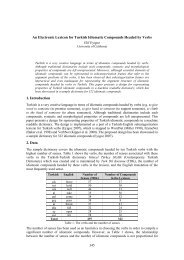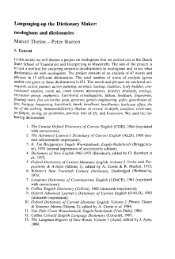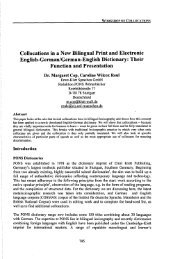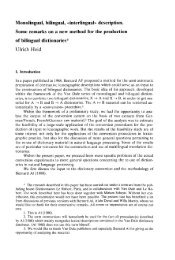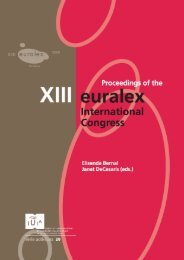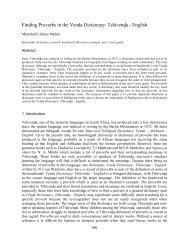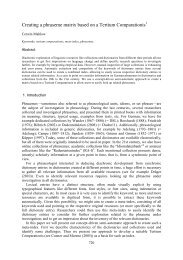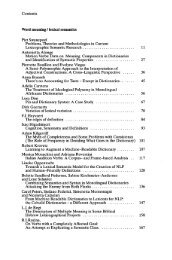Dealing with Lexical Mismatches.pdf - Euralex
Dealing with Lexical Mismatches.pdf - Euralex
Dealing with Lexical Mismatches.pdf - Euralex
Create successful ePaper yourself
Turn your PDF publications into a flip-book with our unique Google optimized e-Paper software.
Ma. Antönia Marti, Carmen Soler<br />
Universität de Barcelona,<br />
Secciô de Lingüistica General *<br />
<strong>Dealing</strong> <strong>with</strong> <strong>Lexical</strong> <strong>Mismatches</strong><br />
Abstract<br />
A first approach to lexical translation mismatches reveals that for some subsets a<br />
correspondence <strong>with</strong> morphological and semantic processes can be established which<br />
enables the treatment by means of translation links to represent multilingual<br />
information. A deeper study of the phrases that constitute the mismatch involves<br />
selectional restrictions criteria related to the types in the LKB1. 1<br />
1. Introduction<br />
Languages are known to exhibit distinct preferences in lexicalization<br />
patterns (Talmy 1985) in such a way that some word senses in one language<br />
have to be translated by a phrase in the other, giving rise to a mismatch. The<br />
study of such patterns shows that some kind of mismatches in one language<br />
correspond to morphological processes of word formation (such as<br />
derivation and compounding) and semantic processes (such as metaphoric<br />
and métonymie sense extensions) in the other language. According to this,<br />
some subsets of mismatches can be established and, therefore, treated<br />
together and generalised (Briscoe & Copestake 1991).<br />
This document presents some of the lexical mismatches observed in the<br />
bilingual English-Spanish Spanish-English dictionary VOX-HARRAP'S<br />
ESENCIAL, their organization into different subsets according to the<br />
correspondences mentioned above and their import on translation<br />
equivalence by means of a tlink rule. The first part of this document<br />
concentrates on nominal lexical mismatches. The second part consists of a<br />
description of different subsets showing distinct preferences in lexicalization<br />
patterns. Finally we outline how we intend to study the phrases that<br />
constitute a mismatch taking into account the relationship between its<br />
components.<br />
2. Spanish-English nominal mismatches<br />
We have concentrated our study on nominal lexical mismatches, starting<br />
<strong>with</strong> an examination of some 33% of the Spanish-English part of the<br />
dictionary. We have classified some of the mismatches according to certain<br />
correspondences in order to allow the generalization of lexical rules.
The way words work together / combinatorics 361<br />
2.1. Differences in plurality<br />
Some of the mismatches are due to differences in plurality as a reflection<br />
of a count-mass discrepancy (Copestake & Sanfilippo 1993). This can be<br />
represented by establishing a link between a word and its translation in the<br />
plural form. In this case the equivalence holds between a basic lexical entry<br />
and a lexical entry after plural rule application (Fig. 1):<br />
SPANISH singular ENGLISH plural<br />
arenal (sandy area) sands<br />
clientela (group of customers) customers<br />
comparsa (group of extras) extras<br />
competencia (group of competitors) competitors<br />
PARTIAL TLINK<br />
plural rule<br />
SFS1 SFSO TFSO TFS1<br />
alumnado alumnado pupils pupil<br />
Fig.l<br />
A similar count-mass discrepancy gives rise to individuating phrases such<br />
as (Copestake & Sanfilippo, 1993):<br />
SPANISH ENGLISH<br />
consejo a piece of advice<br />
informaciôn a piece of news<br />
noticia a piece of news<br />
2.2. Derivational morphology<br />
Other mismatches in English correspond to a process of derivational<br />
morphology in Spanish:<br />
2.2.1. In this first example the Spanish suffix -ero, -a attached to a fruit name<br />
creates a new word meaning a 'fruit tree'. This derivational process in<br />
Spanish corresponds to a mismatch in English:<br />
SPANISH ENGLISH<br />
fruit + -ero,-a fruit tree fruit + tree
362 <strong>Euralex</strong> 1994<br />
limon<br />
albaricoque<br />
melocotôn<br />
limon-ero lemon<br />
albaricoqu-ero apricot<br />
melocoton•ero peach<br />
lemon tree<br />
apricot tree<br />
peach tree<br />
Here, as in most of the following examples, a PHRASAL TLINK is used<br />
(Fig.2):<br />
SFS<br />
1 : limonero<br />
TFS<br />
1: lemon 2: tree<br />
grammar rule<br />
Backward application<br />
0: limonero 0: lemon-tree<br />
PHRASAL TLINK<br />
Fig.2<br />
2.2.2. This case is similar to the previous one, the only difference being the<br />
suffix, here -a:<br />
fruit + -a fruit tree fruit + tree<br />
almendr-a almendr-o almond almond tree<br />
aceitun-a aceitun-o olive olive tree<br />
manzan-a manzan-o apple apple tree<br />
2.2.3. Here the suffix -al added to a plant creates a mass noun. Note that<br />
while Spanish only lexicalizes the idea of constituting a group of plants, the<br />
English corresponding phrases seem to go further, marking a difference on<br />
the kind of plant:
The way words work together / combinatorics 363<br />
plant + -al plantation fruit + plantation etc.<br />
aguacate<br />
abeto<br />
abrojo<br />
almendro<br />
alcornoque<br />
trigo<br />
arroz<br />
aguacat-al<br />
abet-al<br />
abroj-al<br />
almendr-al<br />
alcornoc-al<br />
trig-al<br />
arroz-al<br />
avocado plantation<br />
fir plantation<br />
thistle patch<br />
almond grove<br />
cork oak grove<br />
wheat field<br />
rice field<br />
2.2.4. In this case the suffix -ia added to a noun which denotes a certain job<br />
creates the noun of the shop where it takes place. The English equivalent<br />
produces a change in the case (Fig.3):<br />
job + -ia shop job + 's (shop)<br />
joyero joyer-ia jeweller jeweller's (shop)<br />
calderero calderer-ia boilmaker boilmaker's (shop)<br />
abacero abacer-ia grocer grocer's (shop)<br />
PARTIAL TLINK<br />
SFS1-<br />
joyeria<br />
-SFSOjoyeria<br />
genitive rule<br />
• TFSO TFS1<br />
jeweller's jeweller<br />
Fig.3<br />
2.2.5. In the following examples some words <strong>with</strong> Spanish diminutive suffixes<br />
have resulted in frozen forms which have to be considered different lexical<br />
entries. As English lacks this derivative process an adjective is used to<br />
express the correspondence:<br />
i +diminutive suffix<br />
caballo + -ito<br />
bandera + -ita<br />
campana + -ilia<br />
tabla + -ilia .<br />
caballito<br />
banderita<br />
campanula<br />
tablilla<br />
small/little + noun<br />
small horse<br />
little flag<br />
small bell<br />
small board
364 <strong>Euralex</strong> 1994<br />
aro + -ete<br />
area + -eta<br />
botella + -in<br />
2.3. Sense extensions<br />
arete<br />
arqueta<br />
botellin<br />
small ring<br />
small chest<br />
small bottle<br />
The following mismatches in English correspond to métonymie and<br />
metaphoric sense extensions in Spanish.<br />
2.3.1. Metonymie sense extension from a fruit to a fruit tree presenting the<br />
same kind of mismatch in English as the ones in 2.2.1 and 2.2.2.<br />
fruit & tree<br />
fruit + tree<br />
albaricoque apricot tree<br />
anacardo cashew tree<br />
membrillo quince tree<br />
2.3.2. Metaphoric sense extension in which a noun denoting an animal is also<br />
used to express both a quality of a person (therefore CAT=Adj) and the<br />
person itself (CAT=N). The mismatch is produced when, for some animals,<br />
the sense extension in Spanish has no correspondence in English, and also by<br />
the fact that the double category Adj-N is not as frequent in English as it is<br />
in Spanish. The adjective referring to the quality of the animal needs a<br />
support noun:<br />
animal & person<br />
lince<br />
burro,-a<br />
jirafa<br />
ganso<br />
animal<br />
lynx<br />
donkey<br />
giraffe<br />
goose<br />
adj.+ person<br />
sharp-eyed person<br />
ignorant person<br />
tall person<br />
slow/lazy person<br />
2.3.3. Metaphoric sense extension similar to the previous one. English takes<br />
a support noun while Spanish extends the quality to the person:<br />
quality (adj) & person (n)<br />
agonizante<br />
ahogado<br />
beligerante<br />
quality (adj) + person<br />
dying person<br />
drowned person<br />
belligerent person
The way words work together / combinatorics 365<br />
3. English-Spanish nominal mismatches: compounds<br />
We have also examined 33% of the English-Spanish part of the dictionary.<br />
Apart from the mismatches produced by a difference in plurality we have<br />
observed that a great number of nominal mismatches in Spanish correspond<br />
to the compounding process, which seems to be much more productive in<br />
English than in Spanish:<br />
airlift<br />
airline<br />
birthmark<br />
birthplace<br />
bloodbath<br />
bloodshed<br />
bellyache<br />
headache<br />
sundial<br />
sunglasses<br />
puente aereo<br />
linea aérea<br />
marca de nacimiento<br />
lugar de nacimiento<br />
baho de sangre<br />
derramamiento de sangre<br />
dolor de barriga<br />
dolor de cabeza<br />
reloj de sol<br />
gafas de sol<br />
4. Non-nominal mismatches<br />
We present here some of the subsets we found before dealing <strong>with</strong> nominal<br />
mismatches.<br />
4.1 Support verbs<br />
This is a case of verbal diathesis. In Spanish some active transitive verbs<br />
change to pronominal verbs, so-called a "pasiva refleja", by means of the<br />
particle se. Of the three different equivalences found in English one gives rise<br />
to a mismatch as a support verb is necessary.<br />
(a) the same English verb is used in both cases:<br />
quemar(se) t-p to burst<br />
(b) the verb changes:<br />
adjudicar(se) t to award<br />
p to appropiate<br />
(c) a support verb is needed:<br />
anegar t to flood<br />
anegarse p tobe flooded<br />
fundar t to found<br />
fundarse p to be founded
366 <strong>Euralex</strong> 1994<br />
4.2 More derivational morphology: prefixes<br />
4.2.1 The negative English prefix -un can produce a mismatch in the<br />
Spanish equivalence:<br />
unaccomodating poco sociable<br />
unadventurous poco atrevido<br />
unaccompanied sin compahia<br />
unafraid sin miedo<br />
Note that the difference between 'poco/sin' can be regarded as a matter of<br />
selectional restriction as 'sociable, atrevido, ambicioso' are gradable<br />
adjectives.<br />
4.2.2 The English prefixes mis-, pre- and re- are here equivalent to the<br />
Spanish adverbs mal, de antemano and de nuevo.<br />
misbehave comportarse mal<br />
miscalculate calcular mal<br />
prearrange arreglar de antemano<br />
pre-establish establecer de antemano<br />
re-cover forrar de nuevo<br />
re-examine examinar de nuevo<br />
4.2.3. In this case the prefix re- corresponds to a construction <strong>with</strong> a support<br />
verb in Spanish:<br />
reassemble volver a montar<br />
reawaken volver a despertar<br />
5. <strong>Mismatches</strong> and selectional restrictions<br />
As the kind of correspondences we have treated appear to be insufficient<br />
to cover most of the mismatches, we have gone on to study the phrases which<br />
constitute the mismatch, i.e. its elements and the kind of relationship<br />
stablished between its members. The two most frequent constructions are:
The way words work together / combinatorics 367<br />
(1) NOUN + prep + NOUN<br />
(2)a. NOUN + MODIFIER<br />
(adj in Spanish)<br />
b. MODIFIER + NOUN<br />
(English)<br />
headache<br />
afonia<br />
chip<br />
alianza<br />
bermejo<br />
camerino<br />
dolor de cabeza<br />
loss of voice<br />
patata frita<br />
wedding ring<br />
bright red<br />
dressing room<br />
The relationship which holds between the head and the modifier implies<br />
selectional restrictions. In our view the modifiers fill one of the features of<br />
the type associated <strong>with</strong> the head-noun and That at the same time they<br />
specify the noun type they can modify. There is a selectional restriction in<br />
both directions, from the head to the modifier it can support, and from the<br />
modifier to the noun it can accept.<br />
If we take, as an example, "chip -» patata frita (fried potato)" the resulting<br />
mismatch resulting is not just the sum of patata + frita, as a phrasal TLINK<br />
would suggest, it is in fact a more complex relationship where frita fills one<br />
of the features associated <strong>with</strong> the type of the head patata. On the other hand<br />
frita associates <strong>with</strong> a certain type which can support being "fried". The<br />
study of such phrases (noun + adj) and relationship will be the next step in<br />
our work.<br />
Notes<br />
* This research has been supported by the Acquiilex Esprit Project(7315) and by the<br />
PB-91-0854 of the DGICYT.<br />
References<br />
Briscoe.T. and A. Copestake 1991. "Sense extensions as lexical rules" in D. Fass, E. Hinkelman<br />
and J. Martin (eds.), Computational approaches to non-literal language: metaphor,<br />
metonymy, idiom, speech acts, implicature, Proc. oflJCAl Workshop, Sydney, pp. 12-20.<br />
Copestake et al. 1992. "Multilingual <strong>Lexical</strong> Representation" in ESPRIT BRA-3030 ACQUILEX<br />
WPNO.043.<br />
Copestake, A., Briscoe T. 1991. "<strong>Lexical</strong> Operations in a Unification Based Framework",<br />
Proceedings of the ACL SIGLEX Workshop on <strong>Lexical</strong> Semantics and Knowledge<br />
Representation, Berkeley, California, pp.88-101.<br />
Copestake, A., Sanfilippo, A 1993. "Multilingual <strong>Lexical</strong> Representation", ACQUILEXII-Esprit<br />
Project 7315 , January 1993.<br />
Diccionario VOX HARRAP'S ESENCIAL INGLES-ESPANOL ESPANOL-INGLES, 2 Edicion,<br />
Biblograf S.A., Barcelona 1992.<br />
Talmy, L. 1985. "<strong>Lexical</strong>ization Patterns: Semantic Structure in <strong>Lexical</strong> Forms", in T. Shapen, ed.,<br />
Language Typology andSyntactic Description: Grammatical categories andthe Lexicon.vo\.<br />
III. Cambridge: C.U.P. pp. 57-149.



